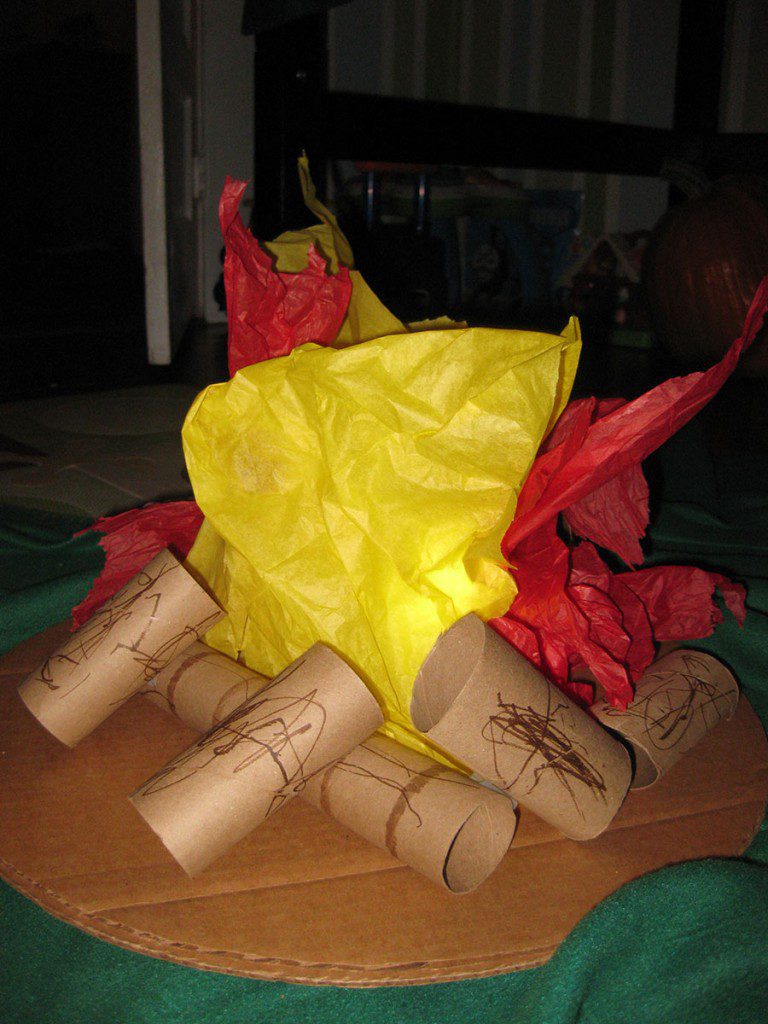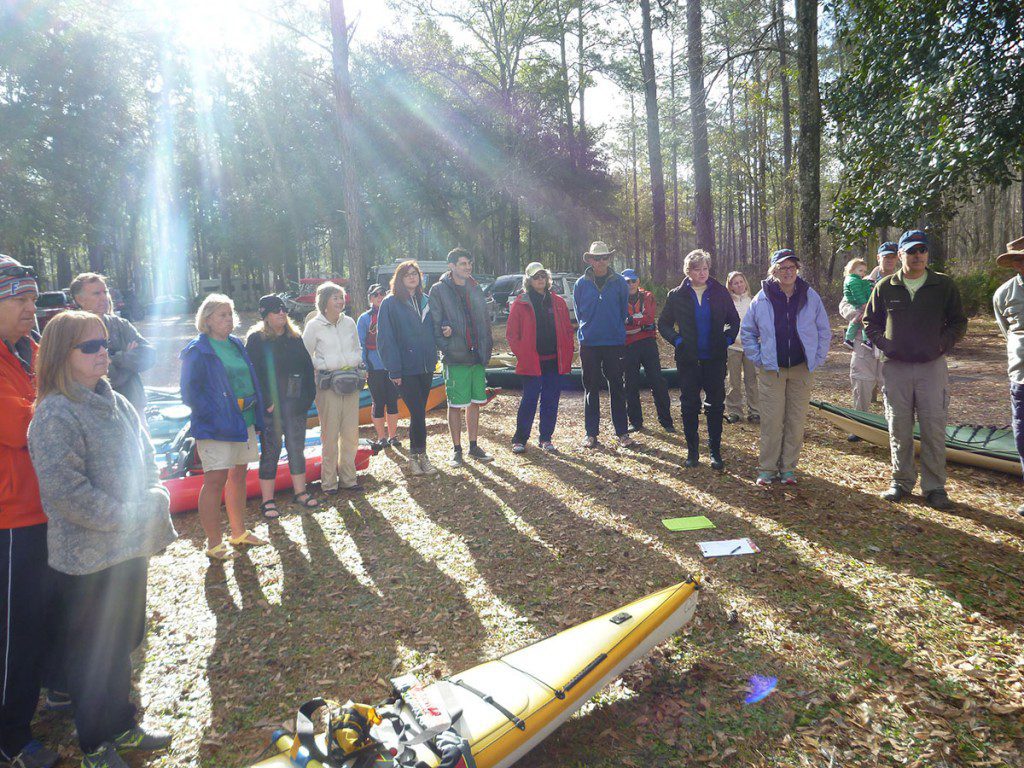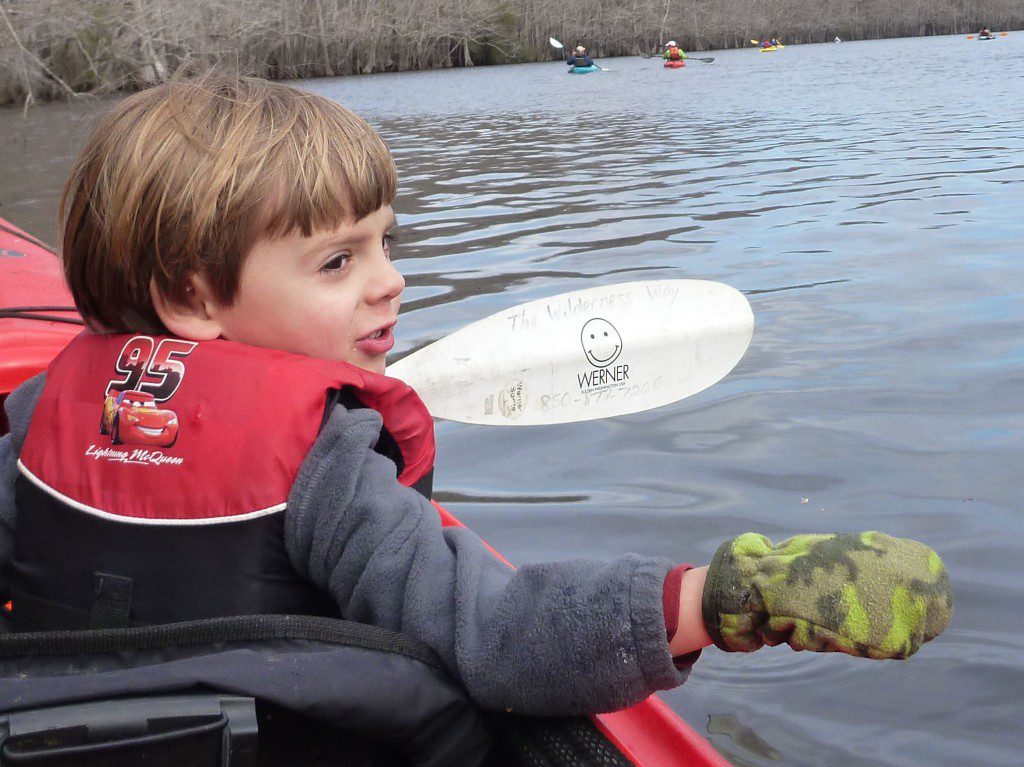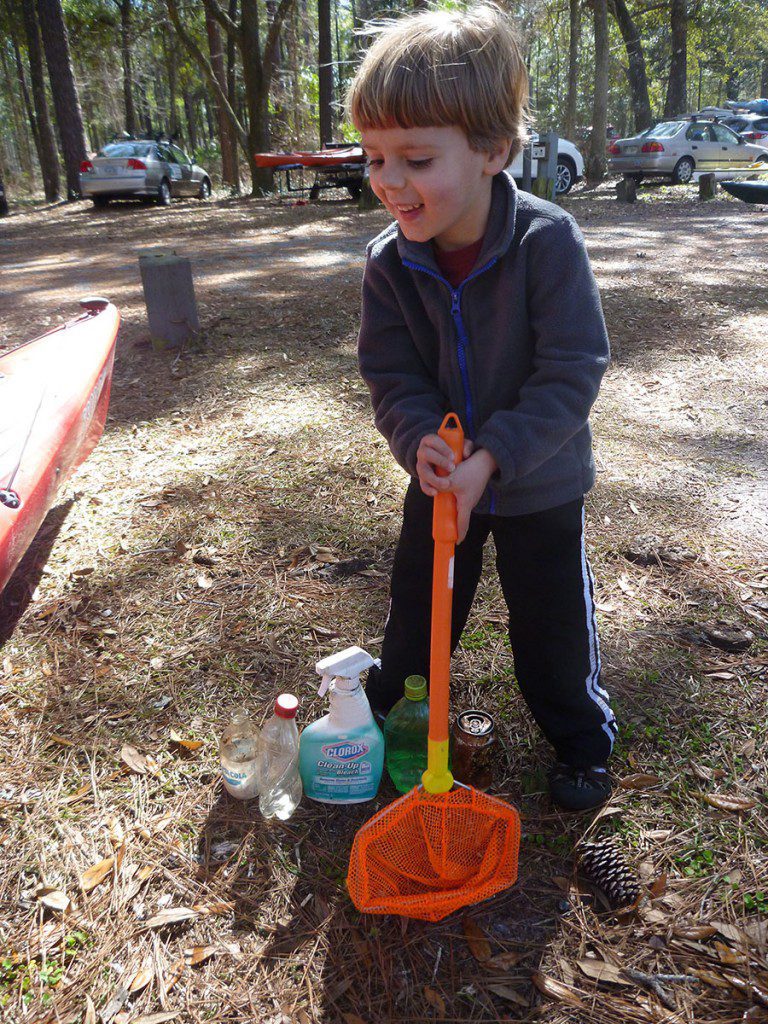Rob Diaz de Villegas WFSU-TV
This past Saturday, my son Max and I returned to Owl Creek to join a few dozen paddlers for a special event. The Apalachicola Riverkeeper welcomed the Florida Wildlife Corridor Expedition as they continue to make their way from the headwaters of the Everglades to Gulf Islands National Seashore near Pensacola. While on the water, I could see that people liked the image of a father and son in a kayak. Other paddlers would occasionally say things like “That’s the right way to raise a kid.” Max and I made a little game of picking up trash along the creek, which garnered more positive comments. It feels nice to hear those things because, honestly, sometimes it feels like I’m just making things up as I go with this kid and his outdoor experiences.
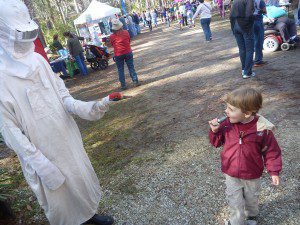
Max uses a duck whistle (every kid in the duck calling contest got to keep theirs) to call an Operation Migration member in a whooping crane feeding suit during the 2015 WHO Festival.
At times, raising your kid to have nature in their lives can be more “rewarding” than “fun.” On other occasions, you battle lack of interest at best, total three-to-four-year-old meltdown at worst. He has never, for instance, shared my love of exploring the St. Marks National Wildlife Refuge. What kid wouldn’t love to strike out and see a bunch of wildlife? Instead, a couple of hundred yards around Headquarters Pond, I hear “I’m tired Daddy, pick me up.” I thought he’d like to see fiddler crabs in the beach and marsh behind the lighthouse. Instead, I can’t pull him away from the map kiosk (he does love the big maps). He did like the excellent children’s activities at the Wildlife and Heritage Outdoor Festival, however. And he loves petting the stuffed otter at the visitor center.
I’m always trying to find that sweet spot between kid friendly activity and the kind of excursion that I would enjoy regardless of whether the family was along. Luckily, we share two favorite outdoor activities: camping and paddling. I could probably go up to Max at any point on any day and say “Drop what you’re doing, we’re going camping,” and have his absolute attention. Even so, it can take a bit of doggedness and creativity to make these adventures work. Saturday was no different.
Managing Expectations
Originally, we were going to camp at one of Owl Creek’s Hickory Landing sites the night before the paddle. Then, the forecast went from a low in the upper 40s to a low of 35. Max was recovering from something heavy earlier in the week; he was still coughing a bit by Friday even if he had regained his characteristic young energy. Still, I hesitated canceling that part of the fun. Why not expose him to some slightly rough conditions and do some character building? Another parent might have chosen to tough it out, but it didn’t feel right to me.
The problem was that I had already brought up that possibility to him. There are no maybes to a four year old. So I decided to camp out right in his room. My wife, Amy, made an indoor “campfire” utilizing a flashlight in a jar surrounded by red and yellow gift bag tissue. When I got home from work, Max was scribbling brown marker on spent paper towel rolls to make logs. We ate hot dogs and s’mores baked right in our oven and slept on the floor in our sleeping bags. We left the lights off and used headlamps and “campfire” for illumination. Max had received some glow-in-the-dark stars for Christmas; I affixed them to his ceiling and we slept under a fluorescent green starscape.
Was it a lot of effort just to keep from disappointing a child? Well, Daddy wanted to go camping, too. And now, Mommy and little brother Xavi got to sit around the campfire as well (Xavi will go camping for the first time in the next few months). Sometimes, we do these things for ourselves as much as for them.
Containing Excitement
The problem with not camping at Hickory Landing, right where the kayaks were launching, is that we had to wake up in Tallahassee, get ourselves ready, and drive for an hour-and-a-half into the Apalachicola National Forest, where Owl Creek runs. And be there by 9 am. We woke up just after 6 am and Max got up out of his sleeping bag a little faster than he normally does when he wakes up for school. But only a little.
“Max, if you don’t get up we’ll be late for kayaking!”
As we drove down State Road 65, flocks of robins and other colorful birds would fly across the interruption in pine flatwood habitat where we drove. In a couple of months, the disturbed, artificially created fringe habitat on the shoulder of this road will burst with a greater diversity of carnivorous plants than you’ll find almost anywhere else.
We pulled into Hickory Landing with a few minutes to spare. Some of my fellow Rivertrekkers were on safety duty for the paddle, and Max and I made our way around saying “Hi,” or in his case “Ooh- ah ah.”
“On Georgia’s packing list, it actually said ‘bring monkey’s paddle,'” said Rick Zelznak. I paddled the river with Rick in 2012. He and his wife, Georgia Ackerman, brought several kayaks and kayaking gear for the day’s trip. Georgia coordinates the Apalachicola Riverkeeper’s RiverTrek fundraiser, a five day paddle trip down the entirety of the Apalachicola. She coordinated today’s affair as well. The monkey paddle to which Rick referred is a child’s paddle Max has borrowed on his other kayaking trips, with smiley faces to let little ones know if they’re holding it right side-up.
We saw other ‘trekkers Max has paddled with recently, such as Doug Alderson and Katie McCormick, who we joined here on Owl Creek for a sliver of the 2014 ‘trek. Others, like Micheal Taber, hadn’t seen Max since that day he toddled down onto the floating dock in Apalachicola to watch us complete RiverTrek 2012. Jill Lingard, with whom I paddled in 2013, had followed his adventures on the blog, but met him for the first time on Saturday (while on the water, no less).
Florida Wildlife Corridor Expedition’s Mallory Dimmitt addressed the group. Max was bouncing a little, and I worried that at any moment I’d have to put my hand over his mouth and carry him away. But he managed to stay mostly quiet during her address and that of Riverkeeper Dan Tonsmeire. Dan pointed out the gnarly, leafless trees around the creek. Right around the time that those carnivorous plants along 65 bloom, so too will the ogeechee tupelo. This region is a mecca for tupelo honey, which relies on the waters of the Apalach and it creeks, sloughs, and swamps. Max may be too young to appreciate the biologically special nature of where we are, but he likes tupelo honey.
And he likes kayaking. Whereas in October we paddled out to where the creek meets the Apalachicola River, this time we paddled up the creek for a longer trip. He’d never seen so many people in the water at once; it was exciting, overstimulating. He grabbed his paddle from behind him and hacked at the water for a few seconds, then gave it back to me. “I’m hungry.” His snacks for the trip were a banana and a granola bar. After eating the granola bar, I carefully received the wrapper from him, nervous that we’d pollute the creek in our first ten minutes on the water. He then grabbed his orange dip net, dragging it on the surface of the water. He didn’t seem to know what to do with his hands.
Occupying Busy Hands
And then, floating there in the water was a vintage Pepsi bottle.
“Max, get your net ready. There’s garbage ahead.”
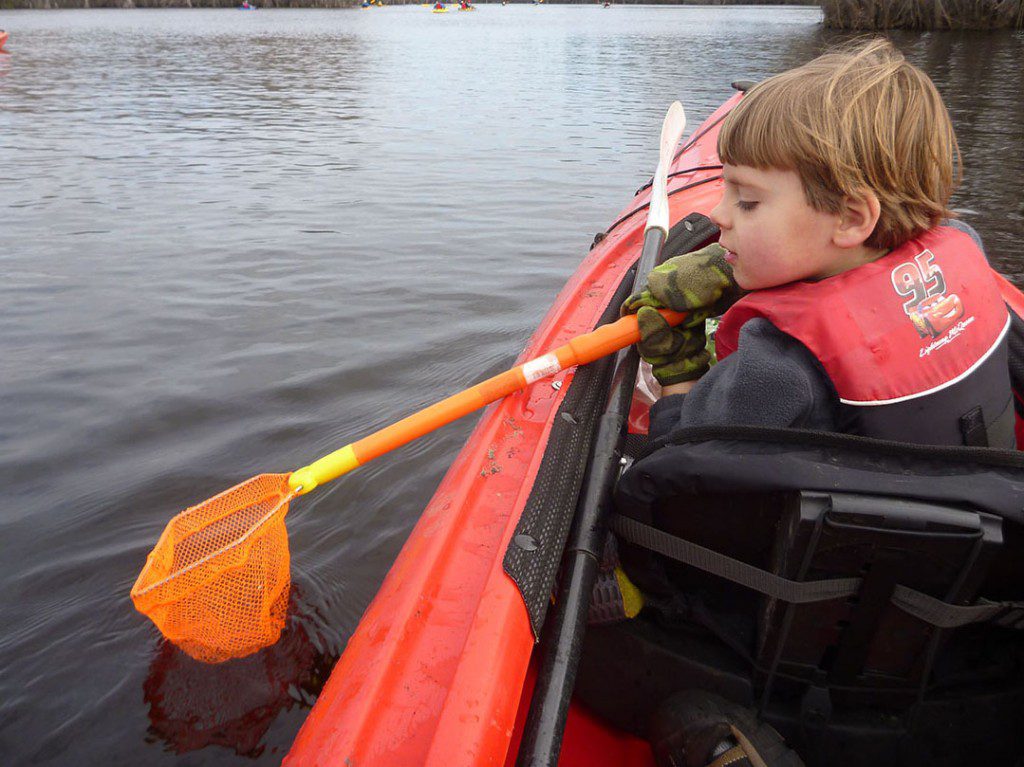 Once the bottle was aboard, I heard someone say “Did they just pick up trash?” People were smiling at us. I was on the lookout now, scanning the banks for bottles that washed up into the cypress and tupelo. Soon, we also had a couple of plastic bottles, a rusty can, and a Clorox spray bottle.
Once the bottle was aboard, I heard someone say “Did they just pick up trash?” People were smiling at us. I was on the lookout now, scanning the banks for bottles that washed up into the cypress and tupelo. Soon, we also had a couple of plastic bottles, a rusty can, and a Clorox spray bottle.
Picking up garbage gave us a little bit of a mission, a focus to occupy my child’s energy. When we went too long without seeing any, he’d start playing with the trash, dipping it back in the water as we propelled forward. To avoid having his boredom inadvertently return the trash to the creek, I’d look for more. Owl Creek is a pretty clean creek, overall. Eventually we ran out of visible garbage.
The garbage in his cockpit served another purpose. With a lot of strangers talking to him, he’d get shy and respond with nothing more than an impish grin. When I’d see him getting shy, I’d say “Show them what you’ve caught.” And he’d pick up every piece of garbage, one by one. A plus is that people would compliment him for picking up trash, which reinforces that behavior.
Building Skill
At 10:45, Doug Alderson in the lead kayak turned around, and we headed back down the creek.
Having run out of trash to pick up, Max got restless again. He’d pick up his paddle and rest it across the cockpit, hands free. “Max! Don’t let the paddle fall in the water!” Another time, he had the paddle out and the net resting on it, hands free. My instinctual reaction was a panicked plea to just get his hands on something and keep it from falling in the water. I became self conscious of how I sounded to surrounding paddlers.
I also became exasperated when he played with his paddle. He’d drag it behind him, in the area where my paddle had to go to move the kayak forward. He’d carelessly twist it in the water. It was annoying sometimes.
But it’s understandable. The trip lasted almost three hours. An adult can enjoy natural splendor and conversation for three hours without much else. For many of us, this is an escape from the noise of our daily worlds. Kids, however, crave more stimulation. On long drives and flights, we have a bag full of books and toys. That day on Owl Creek, I had a paddle, a net, and some garbage for him to play with.
So I worked on developing his paddle skills.
At first, I relied heavily on repeatedly telling him that he had to see the smiley faces. And to move his arms to the middle of the paddle. Sometimes he listened. Sometimes he laughed and twisted the paddle in the water some more.
Passing paddlers were a help. Sometimes kids just respond to advice from adults other than their parents. Mike in the blue kayak, whose last name I didn’t catch, showed him how to hold the paddle. Rick came by and showed him how to scoop the water with his paddle. He was receptive.
But, in the end, what worked best was silly voices and turning the smiley faces into characters.
“Use my face to push the water!” I’d say in a high pitched voice. Then I’d tap the other side of his paddle with mine and say “Now use my face to push the water!” And so on and so forth. Soon, he was able to do this a couple of times:
Once on land again, his little legs were finally unleashed and he was zipping about. As we took a RiverTrek reunion photo, Max was a blur in front of us until Georgia scooped him up. We ate lunch, got in the car, and he was asleep before we were off the forest roads.
As I took the scenic coastal route home, I reflected on the trip. He can be exhausting, this kid. Each trip with him has presented a different set of challenges. When I took him on the Wakulla River, he was sleepy and I wondered whether he might be bored. On our first Owl Creek trip, he was disappointed that the other paddlers continued down the river without us; though eventually we had a fantastic time on our own. Most of our nature outings have been great, even if sometimes it feels like I’m making things up as I go along to keep him engaged. But that’s why I write these posts. I’m no expert, but I’m figuring it out. It’s doable, and I hope parents see that. More kids should be exposed to nature, even if it’s going to your neighborhood pond to see tadpoles in various states of limb growth and turtles basking in the sun (one of my personal favorite activities).
Anyhow, it’s starting to warm up, and the wheels are turning to plan the next adventure. Where should we go next…

